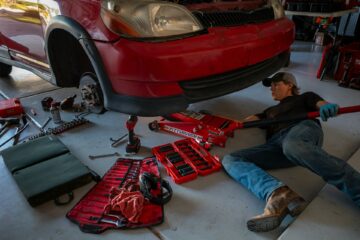The hum of engines, the gleam of polished chrome, and the promise of open roads – the American automotive industry has always been intertwined with the very fabric of the nation. But behind every gleaming showroom and every new car delivery lies a sophisticated and deeply entrenched business model: franchising. Far from a mere handshake agreement, the history of automotive franchising in the U.S. is a captivating tale of innovation, fierce competition, evolving regulations, and the enduring power of local enterprise.
The Dawn of the Horseless Carriage: Necessity Breeds Distribution
In the late 19th and early 20th centuries, as the “horseless carriage” began to transition from a curious novelty to a viable mode of transport, a critical question arose for pioneering automakers: how do we get these complex machines into the hands of a curious but largely uninitiated public? Early manufacturers like Ransom E. Olds (Oldsmobile) and Henry Ford were masters of production, but distributing vehicles across a vast continent presented a significant logistical challenge. The concept of direct sales from factories proved impractical. This necessity gave birth to the first car dealerships, often independent entrepreneurs who saw the potential in this newfangled invention.
These early dealerships weren’t franchises in the modern sense. They were more akin to agents or distributors, buying vehicles outright from manufacturers and then selling them to consumers. However, the fundamental need for local representation, marketing, and, crucially, service and repair, laid the groundwork for a more formalized system.
The Ford Era and the Rise of the Dealer Network
Henry Ford, with his revolutionary assembly line and the mass-produced Model T, amplified the need for a robust distribution network. While he initially focused on efficient production, the sheer volume of cars rolling off the line demanded a systematic approach to sales. It was during this period that the manufacturer-dealer relationship began to solidify, albeit with significant control still residing with the automakers.
By 1917, the burgeoning industry recognized the need for a collective voice, leading to the establishment of the National Automobile Dealers Association (NADA). From its inception, NADA aimed to represent the interests of franchised new-car and truck dealers, advocating for their role in the burgeoning automotive ecosystem. This marked a pivotal moment, as it signaled the growing influence and formalization of the dealer network.
The Roaring Twenties and Post-War Boom: Franchising Takes Hold
The economic prosperity of the 1920s fueled a dramatic increase in car ownership, further entrenching the dealership model. Manufacturers, seeking to expand their reach without incurring the massive capital expenditures of owning and operating every sales outlet, increasingly turned to franchising. This allowed them to leverage local capital and entrepreneurial spirit, while maintaining brand consistency and quality control through contractual agreements.
The post-World War II boom accelerated this trend. As America embraced suburban living and the open road, car sales skyrocketed. The franchised dealership became the cornerstone of automotive retail, offering not just sales but also vital services like maintenance, parts, and financing. This era saw the emergence of iconic dealership names and the strengthening of franchise laws designed to protect both manufacturers and dealers.
Regulatory Evolution and Dealer Protections
While franchising offered immense benefits, the inherent power imbalance between colossal manufacturers and individual dealerships sometimes led to disputes. Manufacturers, at times, wielded significant control, dictating sales quotas, inventory levels, and even dealership operations. This led to a push for greater dealer protection and the gradual development of a complex legal framework.
Key aspects of this regulatory evolution include:
- Early State-Level Interventions: Beginning in the mid-20th century, state legislatures started enacting laws specifically addressing the automotive manufacturer-dealer relationship. These were often a response to perceived abuses of power by manufacturers.
- The Automobile Dealer Franchise Act (1956): Also known as the “Dealer’s Day in Court Act,” this federal legislation was a landmark. It provided dealers with a federal cause of action against manufacturers who failed to act in “good faith” in performing, canceling, or failing to renew a franchise agreement. Its purpose was to balance the power heavily weighted in favor of manufacturers.
- Restrictions on Unilateral Termination: A significant focus of these laws was to prevent manufacturers from arbitrarily terminating dealership agreements without “good cause.” This protected the substantial investments dealers made in their facilities, inventory, and staff.
- Protection Against Direct Competition: Many state laws explicitly prohibit manufacturers from selling new vehicles directly to consumers within a franchised dealer’s territory, thus safeguarding the dealer’s exclusive sales rights.
- Fair Business Practices: Regulations often include provisions ensuring fair allocation of vehicles, reimbursement for warranty work, and limits on manufacturers dictating certain aspects of dealership operations or requiring unreasonable facility upgrades.
- NADA’s Advocacy: The National Automobile Dealers Association (NADA) played a crucial role in lobbying for and shaping these protective laws, consistently advocating for the interests of its dealer members at both the state and federal levels.
These legal frameworks aimed to foster a more equitable relationship, recognizing the dealer’s significant role as a local investor, employer, and brand ambassador.
The Modern Automotive Franchise: Challenges and Adaptations
Today, the automotive franchise model remains the dominant method for selling new cars in the U.S., accounting for the vast majority of new vehicle sales. However, it continues to evolve in response to technological advancements, changing consumer behaviors, and emerging market dynamics.
The rise of the internet has fundamentally reshaped the car-buying process. Consumers now conduct extensive research online, often arriving at dealerships with a clear idea of what they want. This has shifted the dealer’s role from being the primary information provider to a facilitator of the sales process and a crucial point for test drives, financing, and after-sales service.
Furthermore, the advent of electric vehicles (EVs) and direct-to-consumer sales models (most notably by Tesla) has presented a new challenge to the traditional franchise system. While many states still have strong franchise laws that protect existing dealers from direct manufacturer sales, the debate over these models continues to play out in legislative chambers and courtrooms.
Despite these challenges, the franchised automotive dealership model offers several enduring benefits. For manufacturers, it provides a distributed network for sales and service, leveraging local expertise and capital. For consumers, it offers convenience, competition (driving down prices as multiple dealerships of the same brand vie for business), and a reliable point of contact for service, warranty work, and recall management. For local communities, dealerships are often significant employers, tax revenue generators, and active community partners.
The Road Ahead
The history of automotive franchising in the U.S. is a testament to its adaptability and resilience. From the rudimentary distribution systems of the early 20th century to the highly regulated and technologically integrated networks of today, the model has continuously reinvented itself. As the automotive industry navigates the shifts towards electrification, autonomous driving, and new ownership models, the franchised dealership will undoubtedly continue to evolve, seeking to balance the interests of manufacturers, dealers, and, most importantly, the American car buyer. The road ahead promises further innovation, and the enduring legacy of the automotive franchise will undoubtedly play a crucial role in shaping it.












